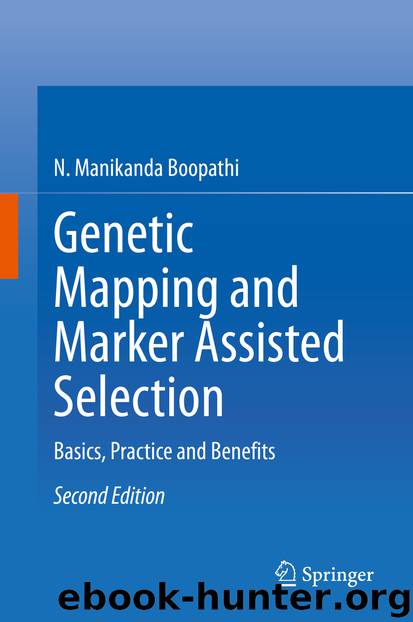Genetic Mapping and Marker Assisted Selection by N. Manikanda Boopathi

Author:N. Manikanda Boopathi
Language: eng
Format: epub
ISBN: 9789811529498
Publisher: Springer Singapore
The chromosomal regions represented by rectangles are usually the region that exceeds the significance threshold (Fig. 7.4). Usually, a pair of markers – the most tightly linked markers on each side of a QTL – is also reported in a table; these markers are known as “flanking” markers.
The reason for reporting flanking markers is that selection based on two markers should be more reliable than selection based on a single marker. Again, the reason for the increased reliability is that there is a much lower chance of recombination between two markers and QTL compared to the chance of recombination between a single marker and QTL.
It should also be noted that QTL can only be detected for traits that segregate between the parents used to construct the mapping population. Therefore, in order to maximize the data obtained from a QTL mapping study, several criteria may be used for phenotypic evaluation of a single trait (for instance, rice yield can be evaluated based on number of panicles, number of spikelet/panicle, 1000 grain weight, etc.).
QTLs that are detected in common regions (based on different criteria for a single trait) are likely to be important QTLs for controlling the trait. Mapping populations may also be constructed based on parents that segregate for multiple traits. This is advantageous because QTL controlling the different traits can be located on a single map.
However, for many parental genotypes used to construct mapping populations, this is not always possible, because the parents may only segregate for one trait of interest. Furthermore, the same set of lines of the mapping population used for phenotypic evaluation must be available for marker genotyping, and subsequent QTL analysis, which may be difficult with completely or semi-destructive bioassays (e.g., screening for resistance to necrotrophic fungal pathogens).
In general terms, the identified QTL may also be described as major or minor. This definition is based on the proportion of the phenotypic variation explained by a QTL (based on the r2 value): major QTL will account for a relatively large amount (e.g., >10%) and minor QTL will usually account for <10%.
Sometimes, major QTLs may refer to QTLs that are stable across environments, whereas minor QTLs may refer to QTLs that may be environmentally sensitive, especially for QTLs that are associated with disease resistance or drought tolerance.
In more formal terms, QTLs are classified as (1) suggestive, (2) significant, and (3) highly significant. This classification was mainly proposed to avoid large numbers of false-positive claims and also ensure that real linkage was not missed. Significant and highly significant QTLs were given significance levels of 5 and 0.1%, respectively, whereas a suggestive QTL is one that would be expected to occur once at random in a QTL mapping study (in other words, there is a warning regarding the reliability of suggestive QTL). The mapping program MapManager QTX reports QTL mapping results with this classification.
Although the most likely position of a QTL is the map position at which the highest LOD or LRS score is detected, QTLs actually occur within confidence intervals (see below).
Download
This site does not store any files on its server. We only index and link to content provided by other sites. Please contact the content providers to delete copyright contents if any and email us, we'll remove relevant links or contents immediately.
| Automotive | Engineering |
| Transportation |
Whiskies Galore by Ian Buxton(41541)
Introduction to Aircraft Design (Cambridge Aerospace Series) by John P. Fielding(32893)
Small Unmanned Fixed-wing Aircraft Design by Andrew J. Keane Andras Sobester James P. Scanlan & András Sóbester & James P. Scanlan(32580)
Craft Beer for the Homebrewer by Michael Agnew(17938)
Turbulence by E. J. Noyes(7717)
The Complete Stick Figure Physics Tutorials by Allen Sarah(7150)
Kaplan MCAT General Chemistry Review by Kaplan(6606)
The Thirst by Nesbo Jo(6450)
Bad Blood by John Carreyrou(6286)
Modelling of Convective Heat and Mass Transfer in Rotating Flows by Igor V. Shevchuk(6231)
Learning SQL by Alan Beaulieu(6043)
Weapons of Math Destruction by Cathy O'Neil(5853)
Man-made Catastrophes and Risk Information Concealment by Dmitry Chernov & Didier Sornette(5672)
Digital Minimalism by Cal Newport;(5397)
Life 3.0: Being Human in the Age of Artificial Intelligence by Tegmark Max(5198)
iGen by Jean M. Twenge(5168)
Secrets of Antigravity Propulsion: Tesla, UFOs, and Classified Aerospace Technology by Ph.D. Paul A. Laviolette(5004)
Design of Trajectory Optimization Approach for Space Maneuver Vehicle Skip Entry Problems by Runqi Chai & Al Savvaris & Antonios Tsourdos & Senchun Chai(4849)
Electronic Devices & Circuits by Jacob Millman & Christos C. Halkias(4756)
